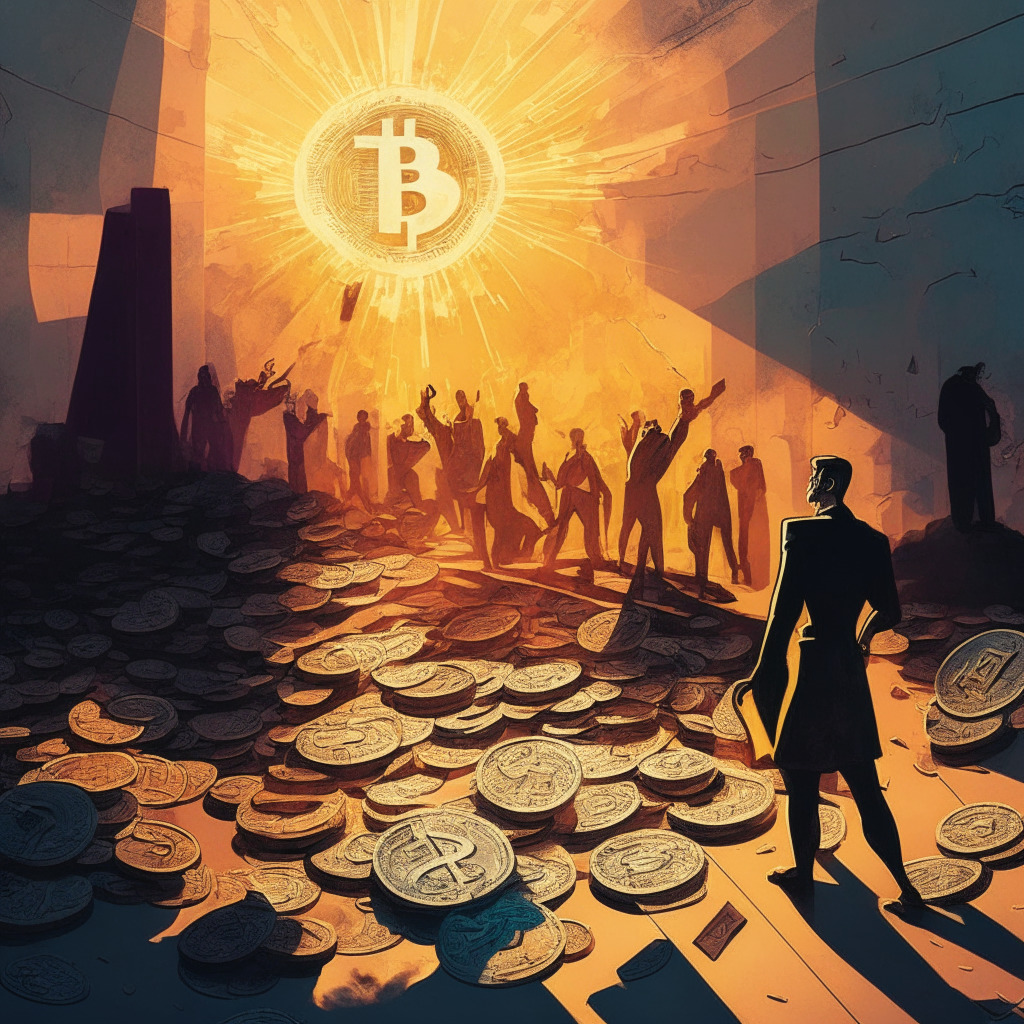The price of Bitcoin has declined by 4.50% over the last week, emphasizing its volatility and sensitivity to market sentiment. Amid concerns about the US dollar’s reserve currency status, Binance CEO Changpeng Zhao believes dollar-based stablecoins could strengthen the dollar; however, he criticized the US regulatory framework for cryptocurrencies. The future of cryptocurrencies appears to be influenced by various factors, including regulatory developments and the potential impact of stablecoins.
Search Results for: Stablecoins
Japan’s MUFG Unveils Progmat Coin: A New Era for Bank-Backed Stablecoins & Cross-Chain Solutions
Japan’s MUFG unveils Progmat Coin, a stablecoin issuance platform supporting local bank-backed stablecoins on multiple public blockchains. The platform aims to provide a universal digital asset payment method for stablecoins, cryptocurrencies, and a Japanese CBDC while addressing potential security concerns.
Japanese Banks Embrace Yen-Pegged Stablecoins: Analyzing Opportunities and Challenges
MUFG’s Progmat Coin platform enables Japanese banks to launch Yen-pegged stablecoins on multiple public blockchains such as Ethereum, Polygon, Avalanche, and Cosmos. As new regulations take effect, banks are exploring or launching stablecoins, potentially advancing mainstream crypto asset acceptance.
Stablecoins: A Solution to Crypto’s Banking Crisis Amid Operation Chokepoint 2.0
Stablecoins may counter the impact of Operation Chokepoint on the crypto sector, providing a solution to the US banking crisis facing crypto companies. Leveraging stablecoins can minimize bank dependency and establish an autonomous parallel financial system, despite potential risks and regulatory challenges.
Japanese Banks Embrace Stablecoins: Will US Institutions be Left Behind?
Japan’s recent legal framework for stablecoins signals a move towards bridging traditional and decentralized finance, while the US faces regulatory hurdles and uncertainty. Japanese banks are now preparing to issue stablecoins as the country embraces distributed ledger technology for faster, cheaper payment systems.
FedNow vs Stablecoins: 5 Key Advantages Keeping Decentralized Assets Relevant
Stablecoins maintain relevance despite the launch of FedNow, offering advantages like global accessibility, financial inclusivity, on-chain transactions, affordable cross-border payments, and handling unrestricted transaction sizes, making them essential in the crypto ecosystem.
Japanese Stablecoins: Navigating New Payment Services Act, Pros and Cons
The revision of the Payment Services Act allows Japanese firms to issue stablecoins, aiming to improve efficiency in cross-border payments, international remittance, and online shopping. The legislation also bolsters anti-money laundering efforts and differentiates between crypto assets and stablecoins. This development could significantly impact the $7.2 billion B2B payments market and foster innovation in financial institutions.
Stablecoins, Politics, and Regulations: Navigating the Crypto Market’s Calm Before the Storm
The cryptocurrency market experienced a flat week, with Bitcoin and Ethereum remaining stable. Meanwhile, ICP and LDO faced losses, while TRON rallied. The growing crypto market attracts political involvement, and regulatory bodies emphasize the need for clear guidelines and vigilance.
Binance Japan GM on Stablecoins Bridging Economic Gap: Opportunities and Challenges
Binance Japan’s general manager, Tsuyoshi Chino, highlights the role of stablecoins in bridging the gap between the real-world and blockchain economies due to their stable value. However, market challenges and gaining regulatory trust remain important factors in promoting broader crypto acceptance.
Whales Shift from Bitcoin to Altcoins and Stablecoins: Future Market Dynamics at Play
While Bitcoin’s trading volume and liquidity are dropping, whales have shifted their focus to accumulating stablecoins and lesser-known altcoins such as Porspoer $PRO, Banqi $QI, and Maker $MKR. Stablecoins like USD Coin, Binance USD, and DAI Stablecoin have seen increased whale interest, indicating future buying power.
Stablecoins for Dairy: Crypto Adoption in Argentina’s Central Market and the Future of Finance
Argentinians are using USDT stablecoin to purchase dairy products at Buenos Aires’ Central Market, thanks to a partnership between Tether and KriptonMarket. This offers a layer of protection against market fluctuations amid the country’s hyperinflation and fiat peso devaluation. Embracing cryptocurrencies showcases the potential for financial freedom in unstable economies while acknowledging the risks and uncertainties involved.
De-dollarization and the Future of Stablecoins: Adapting to a Changing World Economy
The decreasing dominance of the USD as a global reserve currency raises concerns about the future of USD-pegged stablecoins. As countries look for alternative currencies and digital assets, various stablecoins pegged to different fiat currencies or assets could emerge, ensuring stablecoins evolve and remain relevant even if the USD loses its hegemony.
Crypto Adoption Surges in Emerging Markets: DeFi and Stablecoins Lead the Way
Mass crypto adoption is surging in emerging markets like Turkey, Colombia, Nigeria, and Argentina, where cryptocurrencies tackle pressing financial problems. Daniel Fogg explains that these nations lead in crypto adoption due to macroeconomic challenges and increased interest in decentralized finance (DeFi) solutions and stablecoins.
Bipartisan Efforts to Regulate Stablecoins: Finding Common Ground in Crypto Legislation
Two distinct stablecoin bills from US House Financial Services Committee reflect differing perspectives among Democrats and Republicans. Despite differences, lawmakers aim to reach a bipartisan agreement for effective regulation of the burgeoning stablecoin market while protecting consumers and investors.
Crypto Market Unfazed by Debt Ceiling, Stablecoins Diversify, and SEC’s Ripple Case Unveils Secrets
As the U.S. debt ceiling discussions continue, stablecoin issuers like Tether and Circle diversify their reserves amid dollar risks. Meanwhile, a federal judge ruled the SEC cannot seal documents related to ex-official William Hinman’s 2018 crypto speech, potentially revealing the reasoning behind ether not being considered a security.
US Debt Default and Stablecoins: How Circle Aims to Protect USDC Reserves with Repo Agreements
Circle Internet Financial is adjusting the reserves behind the $30 billion USD Coin, considering the possibility of a U.S. government debt default. BlackRock manages the Circle Reserve Fund, now incorporating $8.7 billion in overnight repo agreements as extra protection for the USDC reserve.
Central Banks Vetoing Stablecoins: Balancing Innovation and Financial Stability in the EU
EBA Chair José Manuel Campa emphasizes the need for stablecoins to adhere to sensible guardrails, as central banks should have the right to veto if they threaten monetary policy or financial stability. MiCA’s introduction will regulate all crypto-related activities in the EU, ensuring stablecoin issuers comply with vital regulations while considering central banks’ role.
FedNow and Metal Blockchain Integration: Stablecoins, Privacy, and Financial Future Debated
The Federal Reserve’s upcoming integration with Metal Blockchain has sparked debates on stablecoins, privacy, and financial system plans. Metal Blockchain’s collaboration with instant payment service FedNow aims to enable rapid stablecoin conversions and potentially create interconnected “bank chains” for a secure, oracle-independent blockchain ecosystem.
Stablecoins as Bail Payments: Innovation or Uncertainty for New York’s Justice System?
New York’s Assembly Bill 7024, introduced by Assemblywoman Latrice Walker, proposes authorizing fiat-collateralized stablecoins as bail payment options. If enacted, it could modernize and streamline the payment process, offering increased efficiency while disrupting traditional bail payment methods. However, critics caution against potential unforeseen challenges in the justice system.
Stablecoins as Bail Payments: Innovation or Regulatory Dilemma?
New York Assembly Bill 7024 proposes using fiat-collateralized stablecoins as payment for bail bonds. This could pave the way for wider cryptocurrency adoption in legal proceedings, but concerns arise about its impact on the state’s regulatory landscape and recent efforts by the New York Attorney General to exert control over crypto exchanges.
EU’s MiCA Regulation: Impact on Crypto Assets, Stablecoins and NFTs, and Investor Protections
The European Union is preparing to implement the Markets in Crypto Assets (MiCA) regulation by July 2023, covering crypto-assets and their issuance, trading, and offering. MiCA aims to update the EU with new technologies, introducing stricter rules on stablecoins, increased disclosure obligations for crypto businesses, and implementing anti-money laundering and data security procedures. However, it does not apply to non-fungible tokens (NFTs).
Soaring Bitcoin Fees Push Africa Towards Lightning Network and Stablecoins: Boon or Bane?
Bitcoin users in Africa increasingly adopt the Lightning network and stablecoins as transaction fees soar to a two-year high. The shift in demand results from rising costs on the base layer, leading customers to prefer stablecoins like USDT or opt for faster, low-volume Lightning network transactions. However, challenges persist with instability in wallets, limited exchange support, and congestion. Despite setbacks, this situation could encourage further integration of the Lightning network and growth in the long-term.
DeFi’s Battle of Stablecoins: Curve Finance’s $22M Minting and Its Implications in the Market
Curve Finance recently minted over $22 million of its algorithmic stablecoin, crvUSD, signifying progress towards deployment. Despite competition from other DeFi protocols and concerns following Terra USD’s collapse, Curve Finance aims to differentiate crvUSD as a collateralized-debt-position stablecoin, similar to MakerDAO’s DAI. The integration into DeFi’s user interface remains pending before full release.
crvUSD Launch: A New Era for Algorithmic Stablecoins or Another Failure in the Making?
The decentralized finance world celebrates the successful launch of CurveDAO’s algorithmic stablecoin, crvUSD, with over $22 million minted. Curve’s crvUSD aims to avoid previous pitfalls experienced by other algorithmic stablecoins, potentially reshaping the DeFi ecosystem if successful.
DeFi Surge & FTX Collapse: CBDCs, Tokenized Deposits, & Stablecoins Battle for Dominance
Decentralized finance (DeFi) explores viable alternatives such as central bank digital currencies (CBDCs), tokenized deposits, and fiat-backed stablecoins, each with unique advantages and drawbacks. Their coexistence and success in the DeFi landscape will depend on catering to customer needs and ensuring trust in payment transaction redemptions.
Navigating the Cryptostorm: The Rise and Fall of Binance’s Billion-Dollar Recovery Initiative
“Binance’s ambitious Industry Recovery Initiative (IRI), a billion-dollar fund to rescue struggling cryptocurrency startups, has under-delivered. Only $15 million of the declared $1 billion has been deployed amidst regulatory pressures and lack of suitable investment opportunities. However, the initiative retains its significance in the volatile cryptocurrency ecosystem.”
Unveiling Binance’s $1B Recovery Fund: Generous Aid or Strategic Maneuver?
“Binance’s $1B cryptocurrency recovery fund, the Industry Recovery Initiative (IRI), has reportedly invested only an estimated $30M since its inception, despite large capital commitment. With growing regulatory concerns, unused funds were moved to Binance’s corporate treasury, raising questions about the effectiveness of such recovery initiatives in the evolving blockchain industry.”
Cryptocurrencies in Conflict Resolve: Israeli Cyberspace Crackdown vs. Crypto Aid Israel
The Israeli police cyber unit and Binance tackled Hamas’ attempts to raise funds via cryptocurrency while Crypto Aid Israel, supported by Fireblocks, was established to receive cryptocurrency donations for displaced citizens securely. The growing cooperation could potentially link cryptocurrency assets and traditional banking, crystalizing a hybrid financial future vision.
Ethereum Decline: Diving into the Factors Behind ETH’s Recent Dip
“The recent 8.2% decline in Ethereum (ETH) attributes to increased coin issuance, significant sales by creator Vitalik Buterin, and the underperforming ETH futures ETF. Despite significant network developments, the uncertainty of Ethereum’s monetary policy and increased supply by 30,064 ETH has stirred negative sentiments among crypto enthusiasts.”
Crypto Regulatory Developments: Dichotomy Between Innovation and Oversight
Recent news highlights the dichotomy within the crypto industry – between regulators seeking oversight and proponents advocating decentralization. Examples include the dismissal of SEC’s case against Ripple Labs, new crypto-focused task forces in Hong Kong, changes in stablecoin oversight in Canada, and increased regulation in the UK.
Navigating the Waters of Real-World Asset Tokenization: Insights from Backed’s Latest Launch
“Swiss entity Backed has launched its latest product, bIB01, on the Base blockchain, offering a digital engagement tool for traditional finance enthusiasts. Backed’s tokenized securities, or bTokens, represent real-world assets like corporate bond ETFs and treasury ETFs. Despite limitations for US-based investors, this marks an intriguing merger of traditional assets with digital technology.”
Legal Battle-Skies: The Storm Changing Rules for Crypto-Landlords Bankman-Fried and Mashinsky
“The crypto world is currently watching the judiciary battles involving ex-FTX CEO Sam Bankman-Fried and former Celsius CEO Alex Mashinsky, accused of fraud and market manipulation. These trials, against the backdrop of market reshuffle and increasing regulatory pressure, highlight the need for orderly practices and more comprehensive regulation for long-term crypto market sustainability and investor protection.”































